Serious art collectors can spend weeks at a time chasing the ever present art fair or biennial around the globe in order to catch the latest and greatest in the art world. Obsessed fans should head to Germany next for the 8th rendition of the Berlin Biennale, which is spread across three venues throughout the historic city. This year’s biennial is curated by Colombian/Canadian Juan A. Gaitan, who has focused on a thematic thread of history, and how it relates to art in its many facets. With the artists and installations he has chosen, Gaitan illustrates history and historical becoming in many forms – from pre-war architecture in Berlin, to nineteenth century culture, the political climate during the city’s Prussian past, or even the personal process of memory. The biennale’s venues The KW Institute, the Museen Dahlem and the Haus am Waldsee, were chosen for their specific histories, collections and related locations within Berlin, weaving the city within the fabric of Gaitan’s curatorial intentions.


KW Institute for Contemporary Art, Berlin. Photo by Uwe Walter.
Museen Dahlem. Photo by Maximilian Meisse.
Haus am Waldsee, 2014. Photo by Berndt Borchardt.
Inspired by the Venice Biennale, Klaus Biesenbach, now known as the Director of MoMA PS1 in New York, founded the Berlin Biennale in 1996, taking over the KW Institute for Art as the biennale’s hub. It has since become a symposium attracting international curators, now supported by the German government, and each year centered on a sometimes political theme. The 7th biennale attracted criticism with a theme of activism that reflected the previous year’s Occupy Wall Street movement, yet this year’s edition takes on a slightly less controversial theme with a less pointed focus on history in general. As curator, Gaitan has approached the topic of history from three different perspectives, its relationship to the architectural environment, to citizenship and to labor, as well as a special focus on 18th and 19th century Berlin. The latter looks at the city of Berlin as an artifact, examining its Prussian roots that have been somewhat forgotten. Gaitan has also enlisted an artistic team to provide additional perspectives and curatorial consultation, including Tarek Atoui, Natasha Ginwala, Catalina Lozano, Mariana Munguia, Olaf Nicolai and
Danh Vo.

Catalina Lozano, Juan A. Gaitán, Mariana Munguía, Olaf Nicolai, Natasha Ginwala, Tarek Atoui, 2013. Photo by Thomas Eugster.
Danh Vo & Xiu Xiu, New Collaboration, 2014. Photo by Tova Rudin-Lundell.
Before considering artists to commission for the biennale, Gaitan chose venues that create specific experiences when viewing art, outside of the normal places in Berlin, which are concentrated in the area of Mitte. The KW, always the center of the biennale, is be used to create an inward art experience, letting the art take over and do the talking, so to speak. The Haus am Waldsee was chosen for its historical past as a private villa, and invites visitors to interact with art in relation to the romantic landscape surrounding it. The third venue, the Museen Dahlem, juxtaposes commissioned contemporary art alongside historical artifacts from other cultures, stirring the pot with ideas of empirical acquisitions, cultural mixing, and how modern art and historic relics intertwine. The collection is also planned to move to the forthcoming Humboldt Forum, a centrally located venue, which inspires questions in itself.
Andreas Angelidakis, Crash Pad, 2014. Photo by Uwe Walter.
In addition to these venues, Gaitan has created a venue-within-a-venue at the KW Institute. The first commissioned work for the biennale was
Crash Pad, by
Andreas Angelidakis, which opened in advance of the biennale on January 25. The piece is at once an installation and a functional multi-purpose room, staged at the front of the KW. The piece conjures the great art salons of the 19th century that were used as a meeting of the minds for cultural and political conversations alike. The room itself evokes childhood fort making, made from handmade Greek rugs and columns, which pay tribute to the European and Ottoman iconography that occupied Germany in the past. Aside from this Berlin tie, Angelidakis also references Greece’s first bankruptcy in 1893, which later brought in the International Monetary Fund formed by France, England and Germany in order to assist with the country’s debt. The installation/room is used for events, discussions and cultural exchange throughout the biennale.

Zarouhie Abdalian, a caveat, a decoy, 2014. Photo by Anders Sune Berg.
At the top of the exhibition at the KW sits
Zarouhie Abdalian’s
a caveat, a decoy, a plaster owl that looks out over the Fernsehturm Berlin, also known as the TV Tower, and is regarded as a symbol of Berlin. Nigerian artist
Otobong Nkanga, who spends her time between Antwerp and Berlin, is featured at both the KW venue as well as the Haus am Waldsee. At the KW, Nkanga’s powerful installation,
In Pursuit of Bling, is a multi-media piece that explores her home country’s controversial diamond industry, which feeds the world’s lust for bling at any price.
Otobong Nkanga, In Pursuit of Bling, 2014. Photo by Anders Sune Berg.
At the Dahlem, 50 artists have been commissioned to create work that opens up a dialogue with the historic collection. Colombian artist Alberto Baraya’s flowery pieces, some of which are actual living flowers, play on the work of 19th century German botanist Alexander von Humboldt, reimagining his specimens into lush fine art works.
Mariana Castillo Deball’s pieces are cast from archeological objects, making new sculptures that exhibited together feel as though they are in the storage area of a museum. With these replicas, Deball encourages viewers to consider how the past is presented to a current audience, and how exhibitions can change and skew the perception of history.
Mariana Castillo Deball, You have time to show yourself before other eyes, 2014. Photo by Anders Sune Berg.
The beautiful Haus am Waldsee holds an idyllic escape within itself, inviting visitors to experience the calm of the historic grounds and cavernous rooms as a backdrop for contemporary art. Using this serene setting to his advantage, artist
Matts Leiderstam has created a thoughtful installation that pays tribute to an artwork’s legacy and history. Leiderstam has photographed the fronts and backs of portraits from both the Berlin Portrait Gallery and Stockholm’s National Museum. The pieces are displayed perpendicular from the wall, so that viewers may not only experience the image with think of as the artwork, but also the stickers, notes, and labels that have accrued over the years on their backsides, revealing an alternate history of the art world which includes the personnel who have handled, hung and stored the works over the years. Mathieu Kleyebe Abbonenc’s room examines how collections are recorded, stored, categorized and grouped. Framed photographs depict historical African artifacts, hand-written lists illustrate instructions for anatomical processes, and a snippet of an entomology collection is shown with scientific bottles containing varying larval stages of insects. This collection of collections turns the focus from the object being studied instead onto the anonymous researcher who has likely dedicated his or her life to gathering information for future generations.


Matts Leiderstam, Kat. Nr. 0313 (Unknown Unknown), 2014. Photo by Anders Sune Berg.
Mathieu Kleyebe Abonnenc, Sector IXB Prophylaxis of Sleeping Sickness, 2014. Photo by Anders Sune Berg.
The biennale is rounded out with a stand-alone poster series featuring many of the included artists, as an accessible accompaniment that stresses the visual statements made throughout the exhibition. Gaitan’s biennale asks visitors to look at Berlin with fresh eyes, beyond the pinnacle of today’s thriving post-Berlin-Wall metropolis, deep into its history, taking viewers out of their comfort zone and into historical areas that make them aware of the city in new and enriching ways.



























